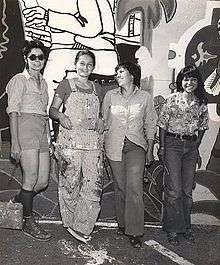Mujeres Muralistas

The Mujeres Muralistas were a woman artist collaborative based out of the Mission District in San Francisco in the 1970s. They were a group of Chicana artists who created large and colorful murals, often focused on womanhood, beauty, and socio-political change. They created public murals throughout the Bay Area and are said to have sparked the beginning of the female muralist movement in the US and Mexico. Prominent members were Patricia Rodriguez, Graciela Carrillo, Consuelo Mendez, and Irene Perez.[1]
History
The Mujeres Muralistas grew out of the Mexican muralist movement in the US and Mexico, which started in the 1920s and was headed by well-known Mexican artist Diego Rivera.
Murals
Unlike the often violent and heavily political murals of the largely male Mexican muralism movement, the Mujeres Muralistas focus was on women's perspectives, and especially Chicana's perspectives. Prominent Mujeres Muralista artist Patricia Rodriguez has commented on the group's work saying, "The statements that we made were very feminine and we got a lot of criticism because we weren’t doing soldiers with guns, weren’t doing revolutionary figures. We were painting women. Women in the marketplace, women breastfeeding, women doing art. People got really angry that we were doing that. ‘How could you do this when there’s so much going on?’ but we were saying that being a women is a revolution in society."[2]

Their first publicly commissioned mural was called "Latinoamerica", located on Mission Street, and painted for the Mission Model Cities organization. The painting of this mural garnered media attention, and the Mujeres Muralistas were interviewed for newspapers, radio, and television. As a result of this publicity, many more women wanted to join the Mujeres and the group began to grow.
In her essay "Mujeres Muralista", published in the anthology Ten Years That Shook the City: San Francisco 1968-78, Muralista Patricia Rodriguez said that "the mural spoke to who we were and where we came from. As Latina artists raised and educated in the US we had the best of both worlds, connecting art school influences with our cultural roots."[3]
References
- ↑ "Mujeres Muralistas". San Francisco Digital Archive. Retrieved 24 November 2015.
- ↑ "Interview with Patricia Rodriguez of Las Mujeres Muralistas". Eternal Queens. 29 April 2013. Retrieved 24 November 2015.
- ↑ Rodriguez, Patricia. "Latinoamérica by Mujeres Muralistas". San Francisco Digital Archive. Retrieved 24 November 2015.